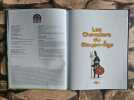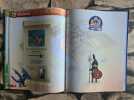-
Type
Book (560)
Magazine (3)
-
Latest
Last 3 days (1)
Last month (13)
-
Century
19th (1)
20th (223)
21st (206)
-
Countries
Belgium (81)
Canada (1)
France (478)
Switzerland (3)
-
Syndicate
ALAC (1)
ILAB (9)
NVVA (3)
SLACES (3)
SLAM (5)
Art Moves. The Material Culture of Processions in Renaissance Perugia
, Brepols - Harvey Miller, 2019 Hardback, iv + 323 pages, Size:220 x 280 mm, Illustrations:69 col., Language: English. ISBN 9781909400832.
Summary "Art Moves" reconstructs the appearance and conditions of use of processional artifacts, whether they were worn (uniforms and liveries), held by individuals, (maces, flags, and candles), or carried communally (canopy, reliquaries, banners, or statues). This is the first book on the material culture of processions as a performative, multi-media, apparatus. It investigates how objects were charged with meaning from medium and fabrication to market value to size and weight. Ritual settings gave them a symbolic force that was heightened through their mobility. In the public events studied here - religious and civic celebrations, elite funerals, papal entries, city-wide penance, and relic transfers - 'moving' [pun intended] objects became the meaningful vehicles of ritual efficacy, shaping ideology, group solidarity, and social cohesion. Despite the liturgical framework, processional paraphernalia foregrounded the laity, notably secular authorities and confraternities. Art Moves also raises the issue of conflict that material ephemera could invite or even spark. Renaissance Perugia, a middling-sized city, presents a wealth of textual, visual, and material evidence, not to mention its medieval and renaissance topography. In Perugia more than anywhere else perhaps, several banners played a key role in crisis processions, becoming cult objects revered into the nineteenth century. This study also revisits artistic representations of corteges, questioning the extent of their documentary value. The approach intertwines the disciplines of art history, social history, material culture, religious studies, and anthropology. This publication offers a new way of looking at the dynamics of urban processions while revivifying the sensory experience of public life in Italy, ca. 1350-1600. With a preface by Jean-Claude Schmitt.
Eloge du cul et autres textes
LA MUSARDINE 2006 159 pages 11x1 4x17 6cm. 2006. pocket_book. 159 pages.
Bon état
Grammaire 3e : Discours textes phrases: Discours textes phrase Livre de l'élève
Belin 2003 256 pages 19 4x1 6x27 2cm. 2003. Broché. 256 pages.
Pellet Eric Haubert Dominique Voltz Francine Vulpillières Catherine de Paccalin Margherita
Reference : 500100514
(2002)
ISBN : 9782701131450
Grammaire 4e: Discours textes phrase Livre de l'élève
BELIN EDUCATION 2002 336 pages 19 4x1 6x27 2cm. 2002. Broché. 336 pages.
Bon état
Greek Myths and Mesopotamia: Parallels and Influence in the Homeric Hymns and Hesiod
Routledge 1997 292 pages 13 97x21 59x1 6764cm. 1997. Broché. 292 pages.
Très Bon Etat de conservation intérieur propre bonne tenue
Prepabac Cours Et Entrainement: Maths 2de
Editions Hatier 2013 13 8x1 6x18 8cm. 2013. Broché.
Bon état
Temps forts
Racine Lannoo 1996 15 6x1 6x22 6cm. 1996. Broché.
Comme neuf encore sous son plastique d'emballage
La maladie: Recueil de textes non bibliques pour réfléchir méditer célébrer
ATELIER 1995 14 6x0 8x21 2cm. 1995. Broché.
Très bon état - légères marques de lecture et/ou de stockage mais du reste en très bon état- expédié soigneusement depuis la France
PLAYMOBIL HISTOIRE
Planeta DeAgostini 2022 2080 pages 2022. Relié. 65 volume(s). 2080 pages.
Bon état
L'Art corporel
Paris Limage 2 - Alin Avila. Collection "mise au point sur l'art actuel". 1983 In-12 en hauteur Broché
EDITION ORIGINALE. Une des premières étude sur ce mouvement, détaillant le travail de Vito Acconci, Günter Brus, Chris Burden, Luciano Castelli, Gilbert et george, Michel Journiac, Juergen Klauke, Urs Lüthi, Henri Maccheroni, Bruce Nauman, Hermann Nitsch, Gina Pane, Peter Stembera Biographies des artistes. Nombreuses photos en noir de performances. 144 pp. --- Le critique qui avait déjà écrit sur le sujet pour une exposition chez Rodolphe Stadler en 1975 étoffe ici son propos. Très bon 0
Pommier Patrick Koné Martine Rolando Jean-Michel Collectif
Reference : 500058959
(2011)
ISBN : 9782210521131
Odysséo Découvrir le monde CP-CE1 en 64 enquêtes - Livre de l'élève: Programme 2008
MAGNARD 2011 160 pages 21 8x1 2x28 6cm. 2011. pocket_book. 160 pages.
Bon état
Ponchard Grégory Squarzoni Philippe
Reference : 500141297
(2005)
ISBN : 9782849610237
Drancy-Berlin-Oswiecim
Requins marteaux 2005 36 pages 19 4x0 6x19 6cm. 2005. Broché. 36 pages. Exemplaire de bibliothèque déclassé
Etat correct
La Dictee Coquine - épisode 1: Tome 1 15 dictées érotiques pour pimenter votre orthographe
Assimil 2020 128 pages 19 2x23 1x2 4cm. 2020. Broché. 128 pages.
Très bon état
La Dictee Coquine - épisode 1: Tome 1 15 dictées érotiques pour pimenter votre orthographe
Assimil 2020 128 pages 19 2x23 1x2 4cm. 2020. Broché. 128 pages.
Très bon état
La Dictee Coquine - épisode 1: Tome 1 15 dictées érotiques pour pimenter votre orthographe
Assimil 2020 128 pages 19 2x23 1x2 4cm. 2020. Broché. 128 pages.
Comme neuf - livre issu de destockage - pouvant présenter d'infimes traces de stockage - Expédié soigneusement dans emballage adapté
La Dictee Coquine - épisode 1: Tome 1 15 dictées érotiques pour pimenter votre orthographe
Assimil 2020 128 pages 19 2x23 1x2 4cm. 2020. Broché. 128 pages.
Très bon état - légères marques de lecture et/ou de stockage mais du reste en très bon état- expédié soigneusement depuis la France
La Dictee Coquine - épisode 1: Tome 1 15 dictées érotiques pour pimenter votre orthographe
Assimil 2020 128 pages 19 2x23 1x2 4cm. 2020. Broché. 128 pages.
Très Bon Etat
La Dictee Coquine - épisode 1: Tome 1 15 dictées érotiques pour pimenter votre orthographe
Assimil 2020 128 pages 19 2x23 1x2 4cm. 2020. Broché. 128 pages.
Très bon état - L'ouvrage qui n'a jamais été lu peut présenter de légères traces de stockage mais est du reste en très bon état. envoi rapide et soigné dans un emballage adapté depuis France
La Dictee Coquine - épisode 1: Tome 1 15 dictées érotiques pour pimenter votre orthographe
Assimil 2020 128 pages 19 2x23 1x2 4cm. 2020. Broché. 128 pages.
Très bon état
Potelet Hélène Fouquet Dominique Jeunon Patrick
Reference : 500099982
(2007)
ISBN : 9782218925726
Mots en voyage Français livre unique 4e éd. 2007- Manuel de l'élève
HATIER 2007 400 pages 19 8x1 8x26 6cm. 2007. Broché. 400 pages.
Bon état
L'inconnu du dimanche de Pâques
COOP BREIZH 2014 13x1 8x19 8cm. 2014. Broché.
Très bon état - légères marques de lecture et/ou de stockage mais du reste en très bon état- expédié soigneusement depuis la France
 Write to the booksellers
Write to the booksellers





































